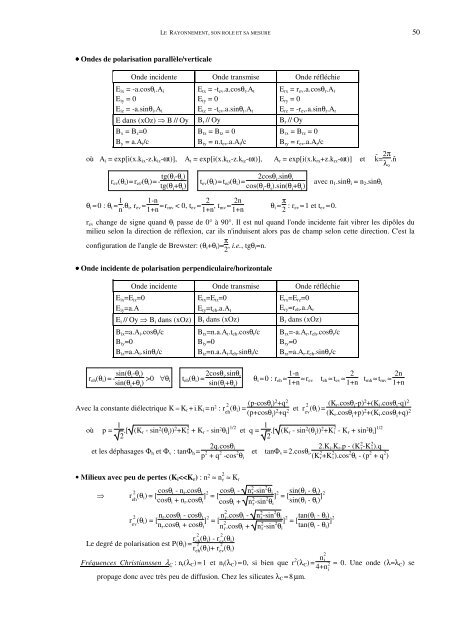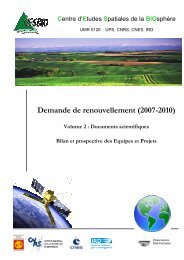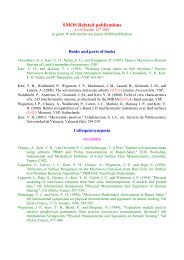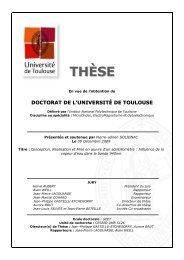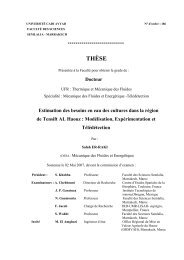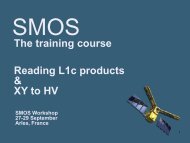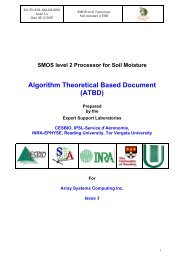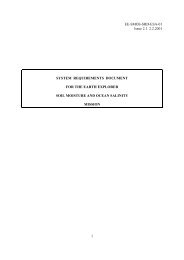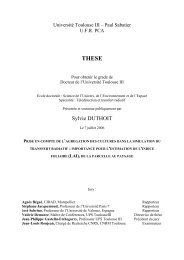Le Rayonnement, sa mesure et son rôle Modélisation du ... - Cesbio
Le Rayonnement, sa mesure et son rôle Modélisation du ... - Cesbio
Le Rayonnement, sa mesure et son rôle Modélisation du ... - Cesbio
- No tags were found...
You also want an ePaper? Increase the reach of your titles
YUMPU automatically turns print PDFs into web optimized ePapers that Google loves.
LE RAYONNEMENT, SON ROLE ET SA MESURE 50• Ondes de polari<strong>sa</strong>tion parallèle/verticaleOnde incidente Onde transmise Onde réfléchieE ix = -a.cosθ i .A iE iy = 0E iz = -a.sinθ i .A iE tx = -t ev .a.cosθ t .A tE ty = 0E tz = -t ev .a.sinθ t .A tE rx = r ev .a.cosθ r .A rE ry = 0E rz = -r ev .a.sinθ r .A rE dans (xOz) ⇒ B // Oy B t // Oy B r // OyB x = B z =0B y = a.A i /cB tx = B tz = 0B ty = n.t ev .a.A t /cB rx = B rz = 0B ry = r ev .a.A r /coù A i = exp[i(x.k ix -z.k iz -ωt)], A t = exp[i(x.k tx -z.k tz -ωt)], A r = exp[i(x.k rx +z.k rz -ωt)] <strong>et</strong> k - = 2πλ o.n -r ev (θ i ) = r e// (θ i ) = - tg(θ i -θ t )tg(θ i+θ t)1θ i ≈ 0 : θ t ≈n .θ 1-ni, r ev ≈1+n ≈ r 2mv < 0, t ev ≈1+n , t mv ≈ 2n1+n2cosθt ev (θ i ) = t e// (θ i ) =i.sinθ tcos(θ i-θ t).sin(θ i+θ t)πθ i ≈2 : r ev ≈ 1 <strong>et</strong> t ev ≈ 0.avec n 1 .sinθ i = n 2 .sinθ tr ev change de signe quand θ i passe de 0° à 90°. Il est nul quand l'onde incidente fait vibrer les dipôles <strong>du</strong>milieu selon la direction de réflexion, car ils n'in<strong>du</strong>isent alors pas de champ selon c<strong>et</strong>te direction. C'est laconfiguration de l'angle de Brewster: (θ i +θ t )= π 2 , i.e., tgθ i=n.• Onde incidente de polari<strong>sa</strong>tion perpendiculaire/horizontaleOnde incidente Onde transmise Onde réfléchieE ix =E iz =0E tx =E tz =0E iy =a.AE ty =t eh .a.A tE i // Oy ⇒ B i dans (xOz) B t dans (xOz)B ix =a.A i .cosθ i /cB iy =0B iz =a.A i .sinθ i /cB tx =n.a.A t .t eh .cosθ t /cB ty =0B tz =n.a.A t .t eh .sinθ t /cE rx =E rz =0E ry =r eh .a.A rB r dans (xOz)B rx =-a.A r .r eh .cosθ r /cB ry =0B rz =a.A r .r eh .sinθ r /cr eh (θ i ) = - sin(θ i -θ t )sin(θ i+θ t) >0 ∀θ 2cosθi t eh (θ i ) = i.sinθ tsin(θ i+θ t)1-nθ i ≈ 0 : r eh ≈1+n ≈ r 2ev t eh ≈ t ev ≈1+n t mh ≈ t mv ≈ 2n1+nAvec la constante diélectrique K = K r + i.K i = n 2 : r 2 (θ (p-cosθeh i) = i) 2 +q 2(p+cosθ i) 2 +q 2 <strong>et</strong> r 2 (θ (K r .cosθev i) =i-p) 2 +(K i .cosθ i-q) 2(K r .cosθ i+p) 2 +(K i .cosθ i+q) 2où p = 1 2 .[ (K r - sin 2 (θ i)) 2 +K 2 i + K r - sin 2 θ i ] 1/2 <strong>et</strong> q = 1 2 .[ (K r - sin 2 (θ i)) 2 +K 2 i - K r + sin 2 θ i ] 1/22q.cosθ i2.K i .K r .p - (K 2 r-K 2 i).q<strong>et</strong> les dépha<strong>sa</strong>ges Φ h <strong>et</strong> Φ v : tanΦ h =p 2 + q 2 -cos 2 <strong>et</strong> tanΦθ v = 2.cosθ i .i (K 2 r+K 2 i).cos 2 θ i - (p 2 + q 2 )• Milieux avec peu de pertes (K i


